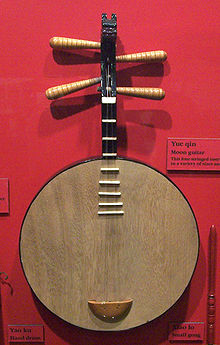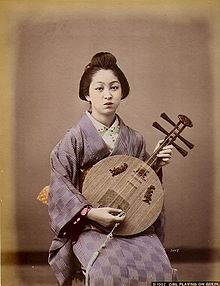- Yueqin
-
This article is about the Chinese Yuequin. The Vietnamese Đàn nguyệt is also often referred to as a 'moon guitar'.
The yueqin (Chinese: 月琴, pinyin: yuèqín, pronounced [y̯œ̂tɕʰǐn]; also spelled yue qin, or yueh-ch'in; and also called moon guitar, moon-zither, gekkin, la ch'in, or laqin) is a traditional Chinese string instrument. It is a lute with a round, hollow wooden body which gives it the nickname moon guitar. It has a short fretted neck and four strings tuned in courses of two (each pair of strings is tuned to a single pitch), generally tuned to the interval of a perfect fifth. Occasionally, the body of the yueqin may be octagonal in shape.photo
According to legend, the instrument was invented in China during the Qin Dynasty.[citation needed] It is an important instrument in the Beijing opera orchestra, often taking the role of main melodic instrument in lieu of the bowed string section.
A similar Japanese instrument, called the gekkin, was formerly used in Japan, particularly around the turn of the 20th century. Another very similar instrument, called đàn đoản or đàn nhat, is occasionally used in Vietnam.
The name Yueqin once applied to all instruments with a moon-shaped soundboard, including the Ruan; however, yueqin now applies to a separate category than the ruan family.
Note that the frets on all Chinese lutes are high so that the fingers never touch the actual body—distinctively different from western fretted instruments. This allows for a greater control over timbre and intonation than their western counterparts, but makes chordal playing more difficult.
Contents
Differences between yueqin and ruan
While both instruments have a moon-shaped soundboard, the modern ruan uses a bridge, whereas the yueqin simply attaches the strings the frame, similar to the design of the pipa. In addition, most yueqin do not have the obvious double soundholes, like the ruan, instead they have the single small soundhole located under the where the strings are attached (also similar to [[pipa). Both features gives the Yueqin a sound quality in between ruan and pipa. While the ruan is used mostly for its lower range instruments (i.e., zhongruan and daruan), yueqin is primarily a treble tuned instrument, even though the size of its soundboard is larger than the zhongruan.
Southern yueqin have a long neck, use two strings, and have an improvisational and flexible intonation practice; some Southern yueqin also have acoustical metal coils inside the soundboard to amplify the instrument. Northern yueqin have very short neck, and have bamboo in both the front and back, requiring the performer to hold the instrument away from their body. The northern instruments range from single to four stringed instruments. Regardless of the neck size or strings, all yueqin are tuned around the same treble pitch level. A common technique in performance is "snapping" the pick on the string (similar to Japanese shamisen.) Yueqin is the loudest member of the plucked lute family of Chinese instruments; one instrument can easily be heard over a full Chinese orchestra.
Traditional yueqin
The yueqin in China has four strings, tuned in two "courses," D and A (low to high). Yueqin used for Beijing opera, however, have two single strings, only one of which is actually used, the lower string being there purely for sympathetic resonance. In Beijing opera, the player uses a small wood dowel instead of a plectrum to perform, and only plays in first position; this requires the performer to use octave displacement in order to play all the pitches within a given melody.
The frets were formerly arranged rather like those on a mountain dulcimer, so that the instrument is diatonic; however, the fret size is high enough that any pitch may be bent up a minor 3rd. Modern yueqin have frets tuned in semitones.
The strings on the traditional form of the instrument were made of silk (although nylon is generally used today) and plucked with a rather long, sharp plectrum, which is sometimes attached to the instrument with a piece of cord.
There is no sound-hole, but inside the sound box are one or more strands of wire attached only at one end, so that they vibrate, giving the instrument a particular timbre and resonance.
There is no bridge or saddle; the strings are simply attached to the anchor at the base of the instrument.
Modern yueqin
Modern forms of the instrument have three or four strings made of steel[citation needed] (or steel-wrapped nylon), each tuned to a different pitch. The strings are attached to the anchor by looping them through their own end-loops.
- 3-string instruments are often tuned A D a,
- 4-string instruments are often tuned to A D a d; however, in recent practice, the instrument is tuned G D g d so modern liuqin and ruan players can easily double on Yueqin.
The anchor on modern instrument may have up to 5 holes, so it can be strung and tuned as a 3- or 4-string instrument. The nut, at the peghead end of the instrument, is filed with notches appropriate to the number and position of the strings.
Modern yueqin are often played with a guitar pick.
See also
- Đàn nguyệt
- Traditional Chinese musical instruments
External links
- (Chinese) Yueqin page
- (Chinese) Yueqin photos (second and third rows)
- (Japanese yueqin page) [1]
- (Page of a Japanese builder and repairer of yueqins) [2]
Video
- Yueqin video: Qing Shen Yi Chang (情深谊长), performed by Fang Jinlong from The Musical Instruments E-book
Traditional Chinese musical instruments Silk (string) Plucked Guqin · Se · Guzheng · Konghou · Pipa · Sanxian · Ruan · Liuqin · Yueqin · Qinqin · Duxianqin Bowed Huqin · Erhu · Zhonghu · Gaohu · Banhu · Jinghu · Erxian · Tiqin · Tihu · Yehu · Tuhu · Jiaohu · Sihu · Sanhu · Zhuihu · Zhuiqin · Leiqin · Dihu · (Xiaodihu · Zhongdihu · Dadihu) · Gehu · Diyingehu · Laruan · Matouqin · Yazheng Struck Yangqin · Zhu Bamboo (woodwind) Flutes Dizi · Xiao · Paixiao · Koudi Oboes Guan · Suona Free-reed pipes Bawu · Mangtong Gourd (woodwind) Sheng · Yu · Hulusi · Hulusheng Percussion Wood Muyu · Paiban · Guban Stone Bianqing Metal Bianzhong · Fangxiang · Luo · Yunluo Clay Fou Hide Daigu · Bangu · Paigu · Tanggu Others Xun · Gudi · Lusheng · Kouxian Categories:- Chinese musical instruments
- Necked lutes
- Beijing opera
Wikimedia Foundation. 2010.



